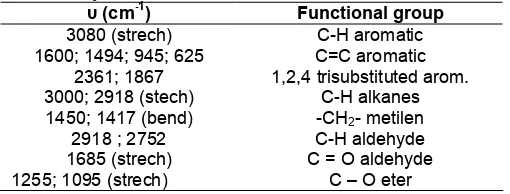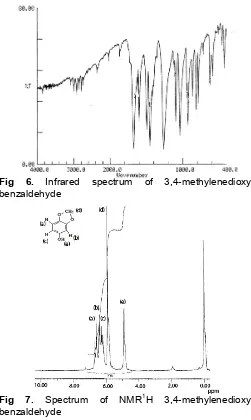THE ADDITION EFFECT OF SULPHANILIC ACID TO
THE SYNTHESIS OF 3,4-METHYLENEDIOXYBENZALDEHYDE
Feti Fatimah
1,*and Sanusi Gugule
2 1Department of Chemistry, Faculty of Mathematics and Natural Sciences, Sam Ratulangi University, Manado
2
Department of Chemistry, Faculty of Mathematics and Natural Sciences, Manado State University
Received May 18, 2011; Accepted October 28, 2011
ABSTRACT
It was conducted a research about the addition effect of sulphanilic acid to the synthesis 3,4-methylenedioxybenzaldehyde from the isosafrole using reagents of sodium dichromate, sulphuric acid, and sulphanilic acid. The separation and purification of product were performed using the chromatography column. The purity of the result was tested using thin layer chromatography and determination of the melting point. Furthermore, it was identified its structure using infrared spectrophotometer, 1H and 13C nuclear magnetic resonance spectrometry, and mass spectrometry. The experimental result showed that the percentage yield of 3,4-methylenedioxybenzaldehyde with addition sulphanilic acid was 79.54%.
Keywords:3,4-methylenedioxybenzaldehyde, sulphanilic acid, isosafrole
INTRODUCTION
In recently years, people try some efforts to get some synthesis about materials of medicine, perfume, and cosmetic. One of the materials needed is a compound of 3,4-methylenedioxybenzaldehyde that is usually called piperonal or heliotropine. Piperonal or 3,4-methylenedioxybenzaldehyde is an important component of perfumery to make soap and used as a raw material to make L-DOPA or derivative medicine of amphetamine [1-4].
The main source to make compound of 3,4-methylenedioxybenzaldehyde is isosafrole, both of produced by oxidation process using chromium (VI), ozonization, electrooxidation, and oxidation microbiologically process [5-8]. Similarly, the compound can be synthesized from the piperonil alcohol using the process of Oppenaur’s oxidation [9]. Synthetically, a process of making 3,4-methylenedioxybenzaldehyde can be performed using raw material of pyrocatechole [2]. The analysis of retrosynthetic is shown in Fig. 1.
Some researchers were tried to synthesis of 3,4-methylenedioxybenzaldehyde compound, but the process still need reagents that need to be hold extra-carefully, such as the use of ozonization reaction. Therefore, it needs to learn some synthetic alternatives, type of reagents, and raw materials that can be used in making compound of 3,4-methylenedioxybenzaldehyde maximally.
One of the alternatives is a process using isosafrole as starting material (Fig. 1) of synthesis result of that natural product of lawang oil. Furthermore,
another reagent alternative that can be used is a strong oxidant such as derivative chromium. Generally, the compounds of chromate (Cr VI) are used to oxidize a functional group of alcohol hydroxyl to be carbonyl aldehyde, ketone, or carboxylic acid [10]. To make a compound of aldehyde, we oxidize a primary alcohol using compounds of chromium-pyridine complex. The reaction can be performed using sodium dichromate placed in aqueous solution [11]. This is supported by the theory that argued that sodium dichromate could oxidize a functional group of olefin forming hydroxyl [12]. Thus, this reaction could be continued to aldehyde. This research will affect to the addition of sulphanilic acid to the synthesize of 3,4-methylenedioxybenzaldehyde using raw material of isosafrole.
EXPERIMENTAL SECTION
Materials
Isosafrole (synthetic), Na2C2O7 p.a. (Merck), H2SO4 p.a. (Merck), CaCl2 anh. p.a.(Merck), NaOH p.a.(Merck), sulphanilic acid p.a.(Merck), powder of silica gel 60 (Merck), benzene p.a.(Merck), chloroform p.a.(Merck), plate of silica gel 60 F254 (20x20) (Merck), acetone.
Instrumentation
Fig 1. Retrosynthetic of 3,4-methylenedioxybenzal dehyde (a) and isosafrole (b)
Electrothermal Melting Point Apparatus, GC-MS Shimadzu QP-5000, Spectrometer NMR1H HITACHI FT-NMR-R-1900, Spectrometer NMR13C HITACHI FT-NMR-R-1900, Spectrophotometer IR JASCO FT/IR-5300.
Procedure
Isosafrole characterizing
The isosafrole used as raw material in the making process of compound of 3,4-methylenedioxybenzal dehyde is synthesis result of natural product of lawang oil. It needs to be characterized before using.
Synthesize of 3,4-methylenedioxybenzaldehyde using reagent of Na2Cr2O7/H2SO4
The reaction apparatus consisted of a 250 mL three necked round bottomed flask provided with a stirrer, a reflux condenser and thermometer which inserted till below the surface of the mixture. Thereafter, a mixture consisting of 2.8 g (17 mmol) of isosafrole, 15.21 g of sulfuric acid, and 100 mL of water was stirred at room temperature. Then, added dropwise a solution of 4.06 g (12 mmol) of sodium dichromate in 20 mL of water, and mix them in about 1.5 h. Make partition as much as three times of the mixture using 50 mL of benzene then dry the benzene using anhydride calcium chloride, and filter and evaporate the filtrates. Separate the residue using chromatography column, while the purification of the result is evaluated using TLC and the melting point determination. Thereafter, the structures were identified with infrared spectrophotometer, 1H and 13
C NMR spectrometry, and GC-MS.
Synthesize of 3,4-methylenedioxybenzaldehyde using reagent of Na2Cr2O7/H2SO4sulphanilic acid
Perform the similar to the procedure (a), but make an addition of 5 mL of sulphanilic acid. The separation of synthesis product was conducted with column chromatography. The purity of synthesis product was tested with thin layer chromatography and melting point determination. Thereafter, the structures were identified with infrared spectrophotometer, 1H and 13C NMR spectrometry, and GC-MS.
Purification of synthetically product using chromatography column
A chromatographic thin layer was conducted to determine appropriate eluents before performing the separation/purification by column chromatography. Based on the result, the appropriate eluents are mixture of benzene and chloroform (9:1). Furthermore, the eluents were evaporated and resulted the desired compound of 3,4-methylenedioxybenzaldehyde. The purities of product were tested with thin layer chromatography and melting point determination by Electrothermal Melting Point Apparatus, while the structure elucidation are identified by gas-chromatography mass-spectrometer, infrared spectrometer, and nuclear magnetic resonance of 1
H and13C spectrometer.
RESULT AND DISCUSSION
Isosafrole characteristic
The characteristic result of isosafrole using spectroscopy showed that the compound can be used as a raw material in making process of 3,4-methylene dioxybenzaldehyde compound.
3,4-Methylenedioxybenzaldehyde characteristic
The compound of 3,4-methylenedioxy benzaldehyde or piperonal can be acquired by the oxidation reaction of 2.8 g isosafrole. Such reaction is performed using the reagent of sodium dichromate in the sulfuric acid. In the second experiment, perform it by adding the sulfuric acid and sulphanilic acid. Then, perform the purification of the experimental result using the technique of chromatography column with adsorbent silica gel, the eluting mixture of benzene : chloroform (9:1).
After the purification was performed, it acquired reaction product (a) of 1.41 g or 50.19%, while by the addition of sulphanilic acid it acquired reaction product (b) of 2.23 g or 79.54%. Both reaction products have form of white crystals and identified as compound of 3,4-methylenedioxybenzaldehyde (piperonal) with the melting point of 36–37 °C, while the melting point according to the literature is 37 °C [3].
This result showed that the reaction product (b) gave the highest percentage yield, i.e. 79.54%. It is caused by the addition of sulphanilic acid. The following figures (Fig. 2 and 3) show the reaction mechanism (a) and (b).
Fig 2. Reaction mechanism (a) of synthesis 3,4-methylenedioxybenzaldehyde
Fig 3. Reaction of formation of intermediate benzilanilinsulphonate (c) 3.4–methylenedioxybenzalde hyde, (b) sulphanilic acid
Fig 4. Chromatogram-spectrum of GC-MS 3,4-methylenedioxybenzaldehyde
Fig 5. Fragmentation pattern of 3,4-methylenedioxy benzaldehyde
Table 1. Data of absorption of 3,4-methylenedioxy benzaldehyde.
υ (cm-1
) Functional group
3080 (strech) C-H aromatic
1600; 1494; 945; 625 C=C aromatic
2361; 1867 1,2,4 trisubstituted arom.
3000; 2918 (stech) C-H alkanes
1450; 1417 (bend) -CH2- metilen
2918 ; 2752 C-H aldehyde
1685 (strech) C = O aldehyde
1255; 1095 (strech) C – O eter
Cr(V) [HCrO3] will oxidize alcohol to produce a carbonyl and a stable Cr (III). In the reaction (b), it was performed using addition of sulphanilic acid. The reaction of the effect of the addition of the sulphanilic acid can be explained by the following reaction mechanism (Fig. 3).
In the process of sulphanilic acid addition, there was a reaction with 3,4-methylenedioxybenzaldehyde which included in the mixture of reaction product, and it performed a compound of intermediate benzylaniline sulphonate. This reaction has effects to the 3,4-methylenedioxybenzaldehyde so there was not any further oxidation in performing piperonilate acid. Then,
the reaction gets the hydrolysis process using alkali
mixture to recover the
3,4-methylenedioxybenzaldehyde.
Furthermore, it is identified the structure of 3,4-methylenedioxybenzaldehyde compound using the infrared (IR) spectrophotometer, 1H and NMR13C spectrometer, and GC-MS. Fig. 4 shows the data of chromatogram and spectrum.
Test result using the GC-MS showed that the reaction product was 1 peak with the retention time of 11.56 min and the concentration of 100%. Fig. 5 shows the interpretation result to the fragmentation pattern.
To identify the functional group, it can be performed test of infrared spectrophotometer. The spectrum can be seen in Fig. 6.
The following table (Table 1) shows the interpretation of the infrared spectrum.
Fig 6. Infrared spectrum of 3,4-methylenedioxy benzaldehyde
Fig 7. Spectrum of NMR1H 3,4-methylenedioxy benzaldehyde
Fig 8. Spectrum of NMR13C 3,4-methylenedioxy benzaldehyde
Interpretation to the spectrum of RMI1H and 13C (Fig. 7 and 8) 3,4-methylenedioxybenzaldehyde can be seen in Table 2.
The compound of 3,4-methylenedioxybenzal dehyde smells very good, so that it used oftentimes as raw material in making perfume and soap perfumery production [14]. Nevertheless, it is reported that the compound has consequences of skin allergy [15]. The analysis result showed that in the United States, a lot people use the compound of 3,4-methylenedioxy benzaldehyde or piperonal or heliotropin as a flavor in cigarettes, although the compound has a bad effect to the health [16].
CONCLUSION
Based on the research result and discussion, it can be concluded that the compound of
3,4-methylenedioxybenzaldeyide or piperonal or heliotropin can be synthesized from the isosafrole and produces reaction product of 50.19%, while the addition of sulphanilic acid produces reaction product of 79.54%. This reaction result showed that there is a positive effect of the addition of sulphanilic acid to the syntheses of 3,4-methylenedioxybenzaldehyde.
REFERENCES
1. Freeman, S., and Alder, J.F., 2002, Eur. J. Med. Chem., 37, 7, 527–539.
2. Bjorsvik, H.R., Lucia, L., and Francesco, M., 2000, Org. Process Res. Dev., 4, 6, 534–543.
3. French, G., 1995,J. Chem. Educ.,72, 6, 485–489. 4. Zarzo, M., 2008, Food Qual. Preference, 19, 3,
315–322.
Acta,39, 4, 497–499.
6. Torii, S., Uneyama, K., and Ueda, K., 1984,J. Org. Chem., 49., 1830–1832
7. Salazar F.C., Avella-Moreno, E., and Cortés, M.T., 2007,J. Electroanal. Chem.,606, 1, 1–7.
8. Santos, A.S., Pereira, N.Jr., da Silva, I.M., Sarquis, M.I.M., and Antunes, O.A.C., 2004, Process Biochem., 39, 12, 2269–2275.
9. Borzatta, V., Capparella, E., Chiappino, R., Impala, D., and Vaccari, A., 2009, Catal. Today, 140, 1-2, 112–116
10. Harding, K.E., Leslie, M., and Kevin, F.D., 1975, J. Org. Chem., 40, 11, 1664–1665.
11. Lee, D.G., and Udo, A.S., 1970,J. Org. Chem., 35,
10, 3589–3590.
12. Awasthy, A.K., and Jan, R., 1969, J. Am. Chem. Soc., 91, 4, 991–996.
13. Roberts, R.M., Gilbert, J.C., Rodewald, L.B., and Wingrove, A.S., 1978, Modern Experimental Organic Chemistry, 3Th Ed., Hott-Saunders Tokyo, 278–279.
14. Poucher, W.A., 1974, Parfums, Cosmetics and Soap Vol.I, BI Publications, 330.
15. Watanabe, K., Midori, M., Shizuka, F., Toshiyuki, K., Tamihide, M., and Ikuo, Y., 2001,J. Health Sci., 47, 3, 327–329

